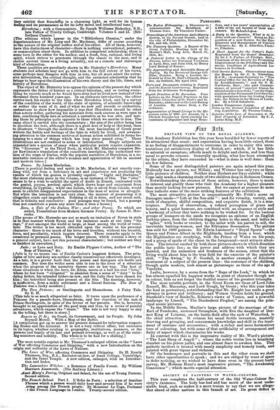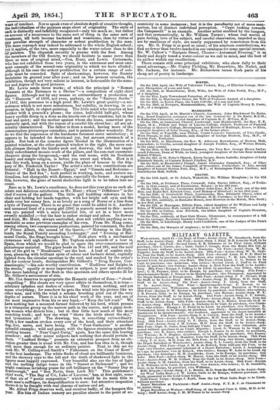SOCIETY OF PAINTERS IN WATER - COLOURS.
This year completes the half-century of the Old Water-Colour So- ciety's existence. The body has had and has merit of the most unde- niable kind, such as makes it a mere truism to say that we are altoge- ther ahead of other nations in this branch of art. Its great defect is want of intellect. Not to speak even of absolute depth of creative thought, the individualism of the painters stops short of originality. The style of each is distinctly and infallibly recognized—only too much so; but rather on account of a recurrence to the same sort of thing in the same sort of treatment, till both become hacknied and wearisome, than by virtue of any peculiar strength of character or ardent predilection in the man. The same reproach may indeed be addressed to the whole English school; yet it applies, of the two, more especially to the water-colour than to the oil painters. The cliqueish security is greater with the first. Among the members of the Old Society, we should hesitate to name more than three as men of original mind,—Cox, Hunt, and Lewis. Cattermole, who has not exhibited these two years, is the extremest and most emi- nent example of the second-rate originality to which we have alluded; although in his case the ardent predilection for a certain range of sub- jects must be conceded. Spite of shortcomings, however, the Society maintains its ground year after year ; and on the present occasion, the exhibition, though not very salient in interest, is honourable for the num- ber and degree of its good pictures. Mr. Lewis sends three works ; of which the principal is "Roman Peasants at the Entrance to a Shrine "—a composition of eight chief figures. Although not by any means so extraordinary a production as the " Haareem " of 1850, nor even, perhaps, as the "Eastern Scribe " of 1862, this possesses to a high point Mr. Lewis's great quality—a mi- nuteness which is not mere minuteness, but subtilty, in drawing, in ex- essi in light, in object-painting. e Th little touches a maid who to b t h
pr on, er
brother with a peacock's plume; the sister, half-child half-girl, whose heavy eyelids droop in a doze as she kneels out of the sunshine, but in the heat and quiet; and the mother against whom she leans, somewhat pre- maturely aged, and with the repose of a careful life about her ; all are ad- mirably characterized. The father is from a model, having more of the commonplace picturesque contadino, and is painted rather woodenly. Nor do we find the expression of the handsome foremost sister satisfactory; it appears to be intended for devotional joy, but savours overmuch of a smirk. But look at the remoter figure flooded in the illumination of a painted window, at the other painted window to the right, the mere out- side glimpse through the hinder arch and doorway, the rich but exqui- sitely subordinated mosaic-work of the pillars, and the sun-cast casement- chequers along the foreground,—and the real scene, with its Southern
re
beauty and simple.ligion, is before you sweet and whole. How is it that this work, hung on a screen, yields the place of honour to the frip- pery of Mr. Frederick Tayler ? The artist's other two contributions are Oriental: "Halt in the Desert—Egypt," and "Camels and Bedouins— Desert of the Red Sea " ; both perfect in working, taste, and austere na- tionalism, but chargeable with flatness, especially the former. As regards this, however, the glare of torrid shelterless light is to be taken into ac- count. Rare as is Mr. Lewis's excellence, he does not this year give us such ab- solute and delicious satisfaction as Mr. Hunt ; whose " Diffidence " is the chef d'oeuvre of the gallery. The little girl huddling sideways in her chair and holding her hands together, with her bright soft eyes and the shade over her sunny face, is as lovely as a song of Burns or a line from a lyric of Tennyson. There is no grace that could be added to it. Another and unnamed head of a young girl (296) is scarcely second to this : never was eye painted with a more beautiful life, or set in a brow more sweetly modelled ;—but the hair is rather stringy and ashen. In flowers and fruit, Mr. Hunt, always unrivalled, does not exhibit anything so re- markable as some previous examples of his own, From Mr. Haag come, among others, two conspicuous productions, painted by command, the first of Prince Albert, the second of the Queen,—" Morning in the High- lands, the Royal Family ascending Lochnagar," and " Evening at Bal- moral Castle, the Stags brought home." Both glare with a mechanical cleverness well nigh offensive. Mr. Topham sends records of a tour in Spain, from which we would be glad to spare the over-consciousness of picturesque material. The gipsy heads in Nos. 147 and 281, and the naïf lighted from the circular openings in the roof, and marked by the artist's be.FirsmtL'iceutty'pturcLes,84 might continue lavishing praise for soft brilliancy on the " Sunny Day at dent.. to be Ensign, by purchase, vice Williams. Scarborough," and " Ben Nevis, from Loch Eil." This gentleman's I Rifle Brigade—Assist-Surg. J. L. Brown, M.D. from the Staff, to be Assist-Surg. chief work, "The Bay of Uri, Lake of Lucerne," has, at first sight, some 1st West India Regt.—J. %V. Lewis, Gent. to be Ensign, without purchase, vice of that air of " poetic composition" which would be its main title to . Kysh, promoted in the Gold Coast Corps. mast men's suffrages, its disqualification to ours : but attentive inspection ,' without purchase. shows it to be fraught with real charms of nature and art. I Depot Battalion at Parkhurst—Staff Assist.-Surg. F. T. B. F. de Chaumont to Mr. Alfred Fripp deserves well, and receives badly, of the hangers this be Assist-Surg. Year. His bits of Italian scenery are peculiar almost to the point of ee- saprge7staff Assist.-Surg. J. H. bilf eece to be Assist-Sure.
'
the stocks," equally or more important in subject, is poor and slovenly. Lieut b2y6itr wohuatse,EvuisciegitSul.toaidt.tsitsut.bluaut. j.liskurfurioutsmetheviStaffittworbes. trAaisrut.: as the best landscape. The white flocks of cloud are brilliantly luminous, be rCritliput. byd,ouervi:, vice de. Ho centricity in some instances ; but it is the peculiarity not of mere man- nerism, but of distinct individual perception. "Capri looking towards the Campanelli" is an example. Another artist snubbed by the bangers, and that systematically, is Mr. William Turner; whose real merits of pure feeling, love of his subject, and careful observation, impeded as they are by smallness of style, are nearly suppressed by remoteness from the eye. Mr. G. Fripp is as good as usual; of his nineteen contributions, we find no fewer than twelve marked in our catalogue for some special interest. Mr. W. Callow's " Eastgate Street, Chester—Autumnal Evening," is as finely and deeply toned a water-colour as we call to mind, and the best of its author within our recollection. There remain still sonic principal exhibitors, who show fully to their usual advantage,—Mr. Copley Fielding, Mr. Branwhite, Mr. Mittel, and Mr. Jackson, for instance. Mr. Richardson issues fresh parts of his cheap art of poetry in landscape.



























 Previous page
Previous page